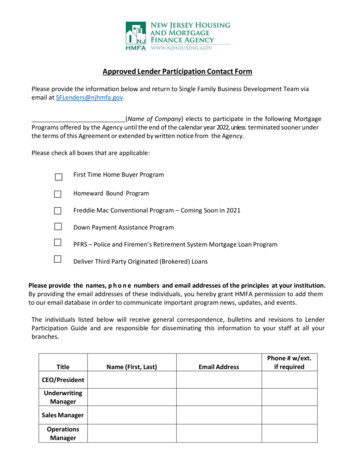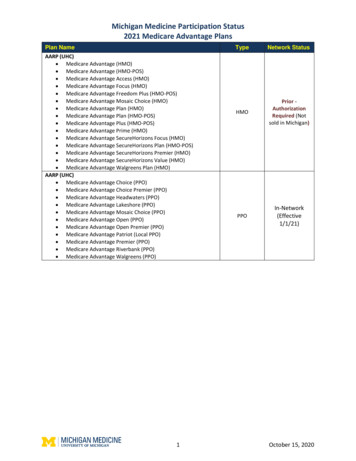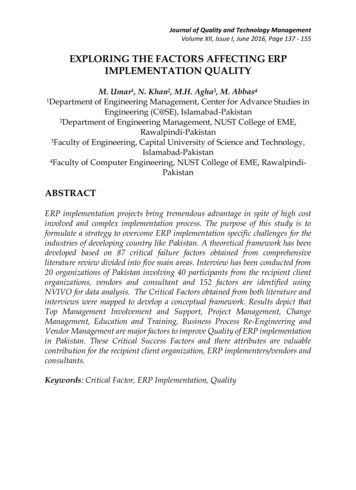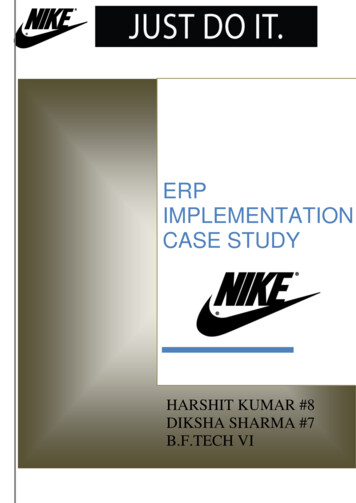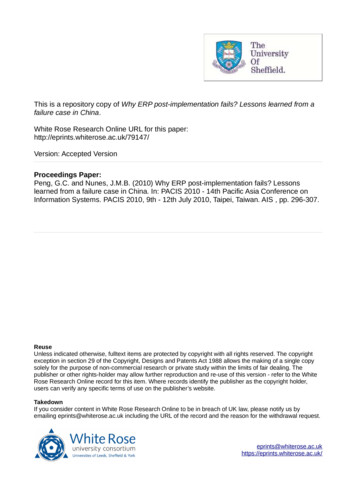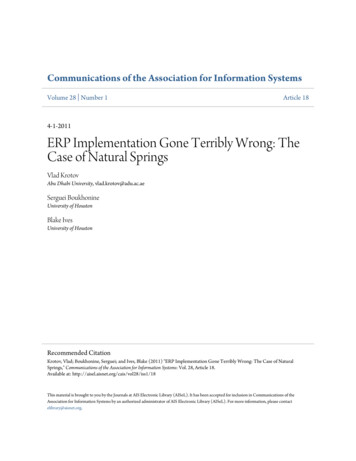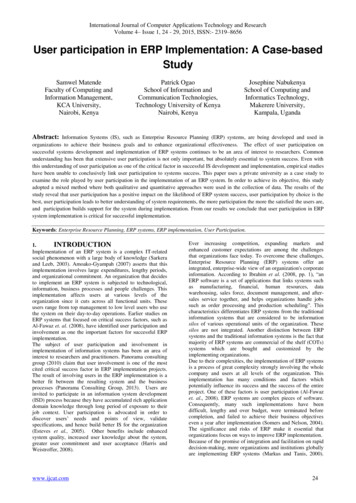
Transcription
International Journal of Computer Applications Technology and ResearchVolume 4– Issue 1, 24 - 29, 2015, ISSN:- 2319–8656User participation in ERP Implementation: A Case-basedStudySamwel MatendeFaculty of Computing andInformation Management,KCA University,Nairobi, KenyaPatrick OgaoSchool of Information andCommunication Technologies,Technology University of KenyaNairobi, KenyaJosephine NabukenyaSchool of Computing andInformatics Technology,Makerere University,Kampala, UgandaAbstract: Information Systems (IS), such as Enterprise Resource Planning (ERP) systems, are being developed and used inorganizations to achieve their business goals and to enhance organizational effectiveness. The effect of user participation onsuccessful systems development and implementation of ERP systems continues to be an area of interest to researchers. Commonunderstanding has been that extensive user participation is not only important, but absolutely essential to system success. Even withthis understanding of user participation as one of the critical factor in successful IS development and implementation, empirical studieshave been unable to conclusively link user participation to systems success. This paper uses a private university as a case study toexamine the role played by user participation in the implementation of an ERP system. In order to achieve its objective, this studyadopted a mixed method where both qualitative and quantitative approaches were used in the collection of data. The results of thestudy reveal that user participation has a positive impact on the likelihood of ERP system success, user participation by choice is thebest, user participation leads to better understanding of system requirements, the more participation the more the satisfied the users are,and participation builds support for the system during implementation. From our results we conclude that user participation in ERPsystem implementation is critical for successful implementation.Keywords: Enterprise Resource Planning, ERP systems, ERP implementation, User Participation.1.INTRODUCTIONImplementation of an ERP system is a complex IT-relatedsocial phenomenon with a large body of knowledge (Sarkeraand Leeb, 2003). Amoako-Gyampah (2007) asserts that thisimplementation involves large expenditures, lengthy periods,and organizational commitment. An organization that decidesto implement an ERP system is subjected to technological,information, business processes and people challenges. Thisimplementation affects users at various levels of theorganization since it cuts across all functional units. Theseusers range from top management to low level users who usethe system on their day-to-day operations. Earlier studies onERP systems that focused on critical success factors, such asAl-Fawaz et. al. (2008), have identified user participation andinvolvement as one the important factors for successful ERPimplementation.The subject of user participation and involvement inimplementation of information systems has been an area ofinterest to researchers and practitioners. Panorama consultinggroup (2010) claim that user involvement is one of the mostcited critical success factor in ERP implementation projects.The result of involving users in the ERP implementation is abetter fit between the resulting system and the businessprocesses (Panorama Consulting Group, 2013). Users areinvited to participate in an information system development(ISD) process because they have accumulated rich applicationdomain knowledge through long period of exposure to theirjob context. User participation is advocated in order todiscover users’ needs and points of view, validatespecifications, and hence build better IS for the organization(Esteves et al., 2005). Other benefits include enhancedsystem quality, increased user knowledge about the system,greater user commitment and user acceptance (Harris andWeistroffer, 2008).www.ijcat.comEver increasing competition, expanding markets andenhanced customer expectations are among the challengesthat organizations face today. To overcome these challenges,Enterprise Resource Planning (ERP) systems offer anintegrated, enterprise-wide view of an organization's corporateinformation. According to Ibrahim et al. (2008, pp. 1), “anERP software is a set of applications that links systems suchas manufacturing, financial, human resources, datawarehousing, sales force, document management, and aftersales service together, and helps organizations handle jobssuch as order processing and production scheduling”. Thischaracteristics differentiates ERP systems from the traditionalinformation systems that are considered to be informationsilos of various operational units of the organization. Thesesilos are not integrated. Another distinction between ERPsystems and the traditional information systems is the fact thatmajority of ERP systems are commercial of the shelf (COTs)systems which are bought and customized by theimplementing organizations.Due to their complexities, the implementation of ERP systemsis a process of great complexity strongly involving the wholecompany and users at all levels of the organization. Thisimplementation has many conditions and factors whichpotentially influence its success and the success of the entireproject. One of these factors is user participation (Al-Fawazet. al., 2008). ERP systems are complex pieces of software.Consequently, many such implementations have beendifficult, lengthy and over budget, were terminated beforecompletion, and failed to achieve their business objectiveseven a year after implementation (Somers and Nelson, 2004).The significance and risks of ERP make it essential thatorganizations focus on ways to improve ERP implementation.Because of the promise of integration and facilitation on rapiddecision-making, more organizations and institutions globallyare implementing ERP systems (Markus and Tanis, 2000).24
International Journal of Computer Applications Technology and ResearchVolume 4– Issue 1, 24 - 29, 2015, ISSN:- 2319–8656Along with this adoption, there has also been a greaterappreciation of the challenges that arise from implementingthese complex technologies. Al-Mashari (2003) asserts thatmany organizations are now adopting ERP systems makingthem today's most widespread IT solutions. For the benefits tobe achieved, the ERP implementation should be successful.Many researchers have identified user participation as acritical success factor in the implementation of informationsystems and ERP systems. The way users participate duringthe development of a traditional information system isdifferent from the way users participate in an ERPimplementation. This paper investigates the role of userparticipation in ERP implementation using a privateuniversity as a case study.The paper is divided into five remaining sections. Section 2presents a review of related literature on user participation andpast research on ERP implementation. Section 3 describes themethodology followed in collection and analysis of data. Abrief description of the case study university and how an ERPsystem was implemented in this university is presented insection 4. The data on user participation in the ERPimplementation process is presented in this section. Section 5gives a brief discussion of the findings while section 6concludes this paper.2.REVIEW OF RELATED WORKSResearch on user participation in the past has focused onidentifying the link between user participation or involvementand success in system development. No conclusive proof ofthis link has been offered by these past researches (Cavaye,1995). Part of the reason for the inconclusive results can betraced back to the lack of clear definition of what userparticipation is. Prior to 1989, user participation andinvolvement were used interchangeably. Cavaye (1995)emphasizes that a clear definition of these terms will resolveambiguities which might have brought about severalinterpretations of the research findings.Traditionally, user participation was defined as userrepresentatives’ participation in IS development process (Ivesand Olson, 1984), with reference to a series of specificactivities undertaken by users (Baroudi et al., 1986). The termuser participation in the information systems discipline usedto be used interchangeably with user involvement till cleardistinction was made between the two by Barki and Hartwick(1989; 1994).Barki and Hartwick (1989) argue that user participation anduser involvement are two distinct concepts with differentmeanings as used in other disciplines. It is worth noting that inthe IS literature, these two concepts have been usedinterchangeably. In trying to differentiate these two concepts,Barki and Hartwick argue that user participation should beused to refer to those activities and behaviours of users andtheir representatives during the development process of aninformation system while on the other hand user involvementshould be used to refer to the subjective psychological statethat reflects the level of importance and personal relevance ofthe information system to users. We adopt this understandingof user participation in this study. We perceive userparticipation to be activities of users and their representativesduring the development and implementation of an informationsystem.Despite the existence of various methodologies, there is a lackof measures to secure effective user participation. Qualitativeresearch has found that users tended to play a marginal,www.ijcat.compassive, or symbolic role in IS development (for example,Beath and Orlikowski, 1994). For example, joint applicationdevelopment (JAD) fell short in promoting effective userparticipation, contrary to common expectation (Davidson,1999; Gasson, 1999). Although participatory design (PD)places a strong emphasis on the cooperation between usersand IS developers, there exists little evidence on theadaptability of this approach beyond the Scandinavian culturalsettings (Carmel et al., 1993).It is difficult for users to participate meaningful for thefollowing reasons: (1) Led by IS staff, users tended to bedrowned in technical materials (Davidson, 1999). (2) Thelanguage of communication between the two sides tends to betechnical, often involving a great deal of jargons (Beath andOrlikowski, 1994; Davidson, 1999). And lastly, (3) Users areput into a passive position, lacking motivation for substantiveparticipation (Wilson et al., 1997). These problems preventusers from participating in IS development in a meaningfuland effective manner. Therefore, there is a clear need forfurther research on methods for effective user participationsince users are the domain experts and carry a wealth ofexperience when it comes to their operation areas.Few studies have been conducted on ERP implementationfrom the perspective of user participation. However, userparticipation issues were also touched upon in two otherbodies of research on ERP implementation, albeit not as themain focus. The first one investigates critical success factorsfor ERP implementation. Secondly, user participationoccasionally appears in recent research on ERPimplementation team from the client side. Prior research hasaddressed the following themes: (1) the important role ofabsorbing ERP knowledge by the user team (Lorenzo et al.,2005; Robey et al., 2002); (2) the various types of ERPknowledge to be learned, such as the functionality of thesoftware, idea of integration (Ko et al., 2005), and projectmanagement methods (Xu et al., 2006); and (3) factorsaffecting the user team’s absorption of ERP relatedknowledge (Ko et al., 2005).Due to the complex nature of these systems, there have beenreports of ERP implementation projects that do not succeed.Sumner (2000) states that there are a number of potentialexplanations for these failures. The failures can broadly beclassified as human/organizational reasons such as lack ofstrong and committed leadership, technical reasons such aschallenges or difficulties that arise from softwarecustomization and testing and economic reasons such as lackof economic planning and justification). Sumner (2000)further asserts that as much as each of these classes isimportant there appears to be a growing consensus amongresearchers that human factors are critical to the success ofERP projects.In summary, the significance of user participation, as animportant issue in ISD, has not been duly recognized in ERPimplementation research. Research on ERP implementationfrom the perspective of user participation is lacking, and thiscould be an area of significant research contribution.3. METHODOLOGYA case study methodology was used in this study. The datacollected for the purposes of this study comes from one casestudy conducted in a private university in Kenya. Qualitativedata collection method (mainly semi-structured interviews)and quantitative data collection method (mainly aquestionnaire were utilized. The interviewees were heads ofdepartments, internal ERP project manager and IT25
International Journal of Computer Applications Technology and ResearchVolume 4– Issue 1, 24 - 29, 2015, ISSN:- 2319–8656technicians. The questionnaire was administered using anonline tool (SurveyMonkey) and it focused on the end users invarious departments such as Finance, Human Resource,Registrar's office, Examinations and some teaching staff. Theusers who filled the questionnaire were identified by the ITManager and the internal ERP project manager.The survey questionnaire asked for information on userparticipation in the ERP implementations. ERPimplementation has different phases and the users participatedin either all or some of these phases. The questionnaire wasfour pages long and had a total of 16 questions addressing thevarious phases of ERP implementation. The questions in thesurvey required multiple responses while others were openended. The responses were encoded using a mix of checkboxes (for multiple choices), radio buttons (for single choice)and open-ended answers
implementation research. Research on ERP implementation from the perspective of user participation is lacking, and this could be an area of significant research contribution. 3. METHODOLOGY A case study methodology was used in this study. The data collected for the purposes of this study comes from one case study conducted in a private university in Kenya. Qualitative


